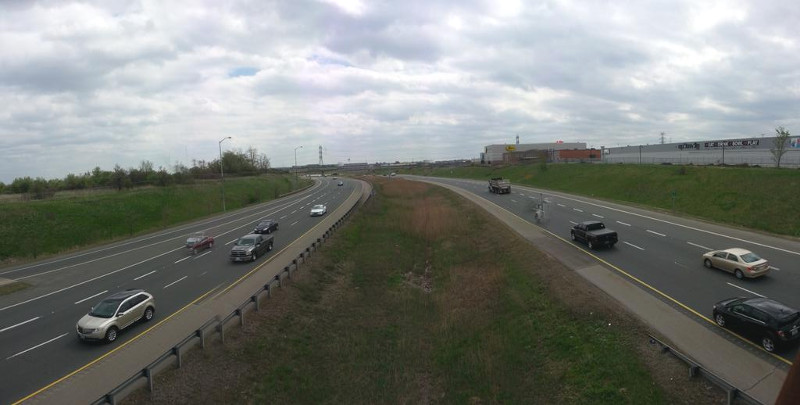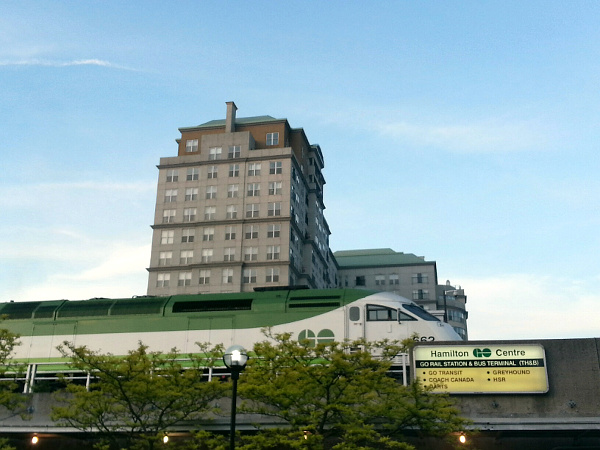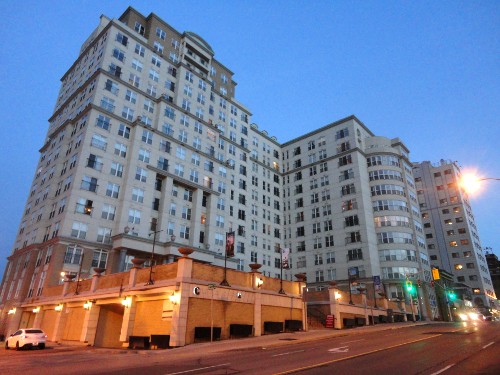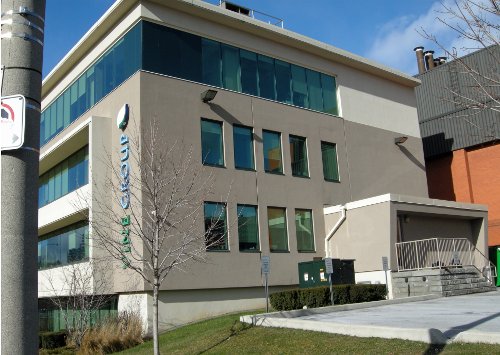We quite simply can't afford to keep approving and building low-density sprawling developments and servicing them with ever-widening highways and streets, which generate yet more low-density development.
By Ryan McGreal
Published May 25, 2015
this article has been updated
We have argued for years that the debate over rapid transit investment in Hamilton cannot be narrowly restricted to the technical matter of moving people. The form and function of our transportation network doesn't just move people around; it also shapes how land is used, and land use has huge impacts on the city.
Lower-density land use causes the per capita public cost to provide infrastructure - roads, water and sewer, waste collection, emergency response - to go up. In turn, higher-density land use causes per capita public infrastructure costs to go down, since the same amount of infrastructure reaches more properties and serves more people.
For a city with an unfunded infrastructure lifecycle deficit of $3 billion and growing by nearly $200 million a year, this is far too important a consideration to ignore.
It is vitally important to understand and make the connection between the kind of transportation infrastructure we build, the form of land use around that infrastructure, and the impacts on the city's financial sustainability.
If we persist in pouring money into the kind of infrastructure that shapes low-density land use, we will continue to dig ourselves deeper into financial trouble. On the other hand, if we get serious about investing in the kind of infrastructure that shapes high-density land use, we can start to dig ourselves out.
City staff and Councillors have begun to muse about spending $80-100 million to widen Hamilton's municipal freeways, the Red Hill Valley Parkway and Lincoln Alexander Parkway, to six lanes to handle the growing volume of automobile traffic.

Red Hill Valley Parkway
Red Hill only opened eight years ago, and automobile traffic has already increased from 65,000 vehicles a day after opening to 80,000 vehicles a day.
This increase in traffic is the predictable result of building the highway itself, which enabled a huge growth in low-density, automobile-dependent suburban development on the east Mountain.
That new development has, in turn, generated huge numbers of new automobile trips while simultaneously saddling the city with vast additional costs to maintain all the new local infrastructure necessary to support it.
Widening the parkways to six lanes will only enable yet more low-density development, which will generate yet more traffic and add yet more pressure to the city's infrastructure debt obligations.
This pattern, in which new lane capacity generates more automobile trips, is called induced demand and is a very well-understood and well-supported phenomenon of traffic engineering.
Unfortunately, municipal leaders rarely acknowledge it, let alone take it into account, when planning road capacity expansions. Instead, they tend to follow a self-fulfilling "predict-and-provide" approach that produces the outcome it assumes.
But induced demand doesn't just apply to automobiles. It applies to all transportation infrastructure, including walking, cycling and transit. When a city invests in high-quality transit - fast, comfortable, convenient and frequent - it generates more transit trips.
Where public policy supports high-quality, high-density development, investment in transit also shapes the kind of land use around the transit line that reduces the City's infrastructure debt by making more efficient use of existing roads.
We actually have examples right here in Hamilton of new investments in high-quality dense development that were shaped by transit investment and supportive public policy.

Early morning GO Train at Hunter Street Station with Chateau Royale in background
After the Hunter Street GO Train Station opened in 1996, Council established a residential loan program to help bridge the financing gap for new urban developments during a time when traditional financial institutions were reluctant to invest in anything other than low-density sprawl.
At the time Council had a sense of urgency about the downtown and recognized that the City could play a valuable in making it easier for sound projects to get financing.
That combination of transit investment and supportive policy precipitated a wave of transit-oriented developments (TOD) that continue to this day.
The Chateau Royale at 135 James Street South started as an office building in 1967 called Alexandra Square, which was run-down and one-third emptyby the late 1990s. Work started on converting the office tower into the residential Chateau Royale in 2002, and the building opened in 2006.

Chateau Royale (RTH file photo)
The GO Station and Residential Loan Program were also catalysts for The Residences at James and Augusta, formerly the Professional Arts building, which was built in 1969. It was converted into a new seniors' building that opened in 2002 and advertised its proximity to the station and several HSR bus lines on James Street.
And the benefits did not merely extend to residential developments. The old Hamilton Health Department Headquarters at 1 Hunter Street East, built in 1954 and later abandoned, sat empty for years before re-opening as a modern office in 2007 after the developer added a floor, renovated the interior and retrofitted an elevator.

1 Hunter Street East (RTH file photo)
Even the most recent new developments, like 150 Main West - the former Revenue Canada building - are still advertising proximity to the GO station:
Main Street is a major artery of Hamilton's City Centre. From here, all things are possible. Shop at Jackson Square. Catch a concert at FirstOntario Centre. Drop by City Hall, the Library, the Art Gallery. Downtown Hamilton's most distinguished landmarks are all within easy walking distance from 150 Main, with easy access to GO Transit.
These urban projects make a huge difference to the City's bottom line. The Homewood Suites at Bay and Main went from paying $18,122.86 to the City in annual property tax to $309,996.18 after redevelopment. (Likewise, the nearby Staybridge Suites Hotel went from paying $11,210.86 to the City to $93,919.24 after redevelopment.)
We quite simply can't afford to keep approving and building low-density sprawling developments and servicing them with ever-widening highways and streets, which generate yet more low-density development. That highway leads to a financial cliff.
A wide array of cities have proven and continue to prove that it is possible for a city - even a low-density, car-dependent city - to choose a more financially sustainable path of development. It requires leadership but it can be done.
The predictable alternative is the two-headed beast of ever-growing traffic congestion and ever-growing infrastructure debt.
Update: this article originally stated that Alexandra Square was vacant in the 1990s. In fact, it was only one-third vacant by the end of the 1990s. RTH regrets the error. You can jump to the changed paragraph.
By kevlahan (registered) | Posted May 25, 2015 at 10:53:18
I noted that in the Spec article the $80-100 million isn't even mentioned as an issue! Not to mention the millions in ongoing maintenance every year for the new lanes.
Quite a contrast to the line-by-line fiscal scolding that very cheap improvements to the sort of active transportation and transit that enhances our urban tax base and leverages existing infrastructure investments incites! (Things like two-way conversion, bus lanes and bike lanes or better sidewalks and crosswalks for pedestrians.)
By Pxtl (registered) - website | Posted May 25, 2015 at 12:17:17 in reply to Comment 111697
I noted the same thing in the Waterdown bypass article - the sudden and conspicuous absence of people complaining about money spent on things other than their pot-holes. This is with price-tags that are hundreds or thousands of times larger than the usual subjects of complaint (arts funding or bike-lanes).
By CharlesBall (registered) | Posted May 25, 2015 at 11:43:31
Alexandra Square was not vacant and derelict in the 1990's. I had an office there from 1989 until I was forced to move in 1998/9. Spent over $100,000.00 renovating the office in 1988 before I moved in. Loved that office. The property was purchased at the time of my eviction specifically to build a condo. The building was far from vacant.
If I had not been evicted I would never have moved. Loved the Undermount.
By CharlesBall (registered) | Posted May 25, 2015 at 11:49:50
BTW - isn't building mass transit an example of induced demand. Just a demand of a different type. (If we keep building railways and LRT's people will use it - especially if we force them to by reducing the viability of private transportation.)
Agree completely though with the wastefulness of building more and more suburban blight. We need to develop brown fields and redevelop the inner cores of all cities. An outright ban on new greenfield development in Ontario is the answer for me - not plugging up private transit. (Why people were ever allowed to develop the land below the escarpment East of Stoney creek is beyond me. The best arable land in Canada wasted. The QEW should be restricted (or closed) not expanded and moved up above the escarpment in the clay.)
By Haveacow (registered) | Posted May 25, 2015 at 12:15:00
During a meeting once, I asked one of my opposites in the road department of the city government I was employed with at the time (I was in the planning and development office), why don't major road projects have to have business cases for their approval as all major transit projects must have? Most would fail miserably was the honest answer I got! The matter was never discussed again!
By Maybe (anonymous) | Posted May 25, 2015 at 12:28:49
Can we area rate expansion and maintenance costs for the RHP?
By DowntownInHamilton (registered) | Posted May 25, 2015 at 23:05:49 in reply to Comment 111705
By Dylan (registered) | Posted May 26, 2015 at 08:24:25 in reply to Comment 111724
I think you missed the mark on this one. From my understanding if all elements are area rated, property taxes downtown would go down, and they'd go up on The Mountain.
By kevinlove (registered) | Posted May 25, 2015 at 12:56:32 in reply to Comment 111705
Love the idea!
By KevinLove (registered) | Posted May 25, 2015 at 12:59:06
I will note that the cost to implement the entire Cycling Master Plan for all of Hamilton's urban area is $22.5 million. This revolutionizes the entire City for a fraction of the cost of any number of proposals which will just flush money down the toilet.
By beancounter (registered) | Posted May 25, 2015 at 16:00:49
It seems to me that the problems discussed in this article have, to a significant extent, originated in silos at City Hall. Perhaps what is needed is more conversations between those that plan land use and those that plan major roads as well as similar coordination between land use and transit planning and between transit and road planning. An excellent outline of how this could be accomplished on a continuous iterative basis is laid out by independent transit consultant Jarrett Walker in his fascinating book "Human Transit: How Clearer Thinking about Public Transit Can Enrich Our Communities and Our Lives". (Washington, DC: Island Press, 2011 – Chapter 16: Take the Long View)
By bvbborussia (registered) | Posted May 25, 2015 at 23:00:16 in reply to Comment 111714
You can live there if they like, but don't demand new roads, schools, hospitals and other public services to come join you once you go.
By KevinLove (registered) | Posted May 25, 2015 at 18:18:05 in reply to Comment 111714
I am an Army veteran who wants to set up a rifle range where I live next to Durand Park. If I'm willing to build it, isn't that fair?
Comment edited by KevinLove on 2015-05-25 18:19:31
By Cultosaurus (registered) | Posted May 25, 2015 at 17:14:28 in reply to Comment 111714
No, but we should force people to pay the actual costs of "choosing" sprawl.
By jason (registered) | Posted May 25, 2015 at 22:11:24
we really need to get de-amalgamation on the table, and seriously, not just some stupid election ploy.
Just in the past few months alone we've heard of hundreds of MILLIONS of dollars planned to be spent on unnecessary roads entering the Ancaster business park, bypass in Waterdown, Waterdown Rd, cloverleaf Waterdown. 17,000 people generating NOTHING for the local economy and they're going to single-handedly bankrupt us because someone spotted a brake light once. Now this from Conley, the guy who said he can't support bike lanes because "we can't afford them".
A true, full 100% de-amalgamation would be such a dynamic wake-up call for these folks. Not the old regional government system that we used to have where the old city had all it's money sent out for sprawl construction in the burbs. I'm talking a true deamalgamation. The old city would be flush with cash overnight. Enough of these dino's ruining the city all the time.
By Tolls (anonymous) | Posted May 25, 2015 at 22:41:57
How about tolls to fund the expansion(s)? After all, it appears transit users are required to pay for necessary upgrades here, why not highway users? It worked for the Skyway Bridge in the '60's, why not the Red Hill now?
By LedPencilPusher (registered) | Posted May 26, 2015 at 08:45:15
In terms of traffic shaping and management, do you think adding express bus service direct from suburban centres like Heritage Green to downtown would make a difference with congestion?
I drive the Red Hill every day and cannot justify spending tens+ millions to address congestion that is only a two or three hour issue at best (hour in the morning, hour at night).
By CharlesBall (registered) | Posted May 26, 2015 at 15:10:24 in reply to Comment 111736
Could you explain "two or three hour issue." Thanks.
You must be logged in to comment.
There are no upcoming events right now.
Why not post one?